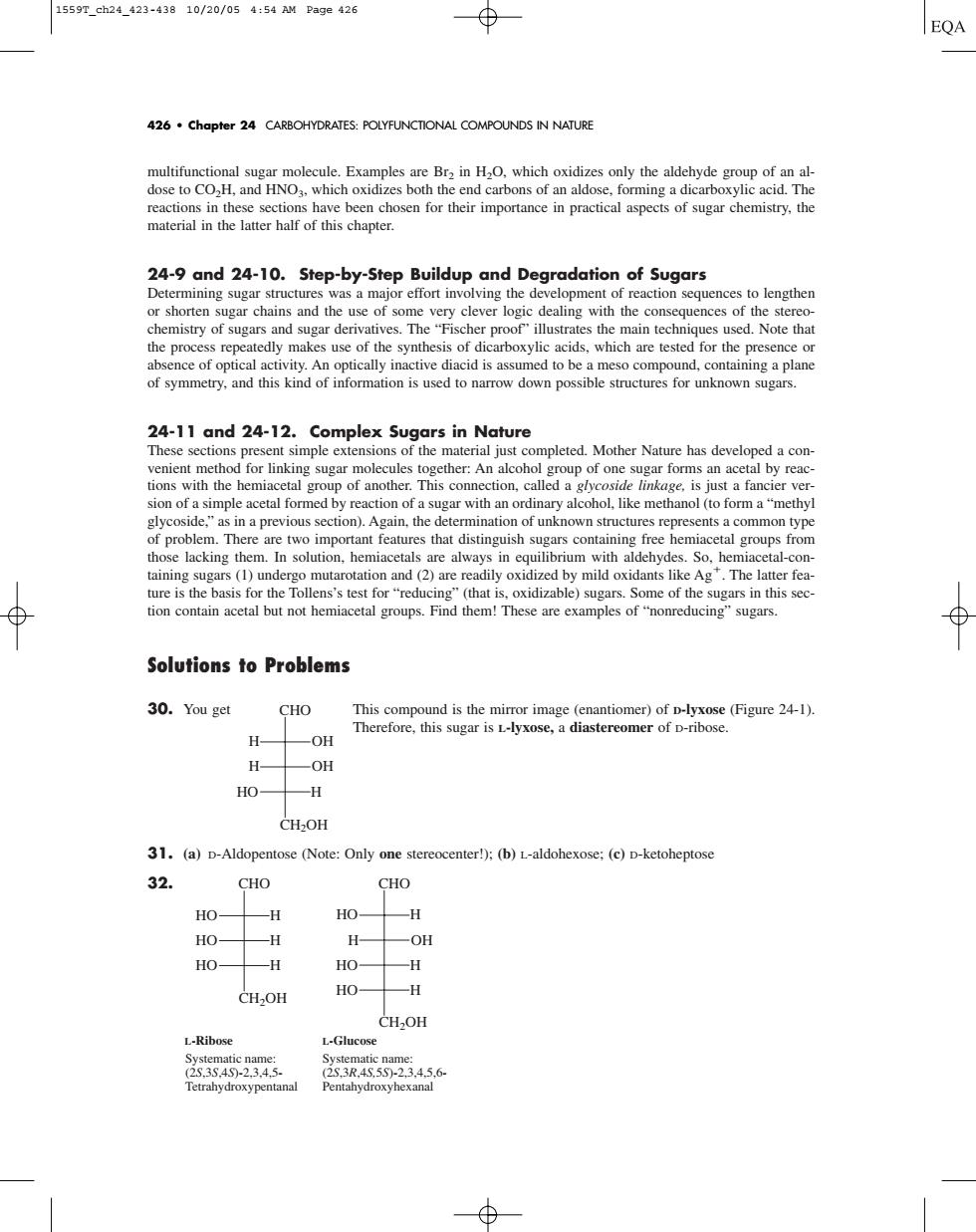正在加载图片...

1559rch24423-43810/20/054:54 AM Page426 426 chapter 24 CARBOHYDRATES:POLYFUNCTIONAL COMPOUNDS IN NATURE reactions in thes cfor their importance pctical apects of r chemisry.the shorten sugar chains and the use of some very clever logic dealing with the consequences of the stereo h of the ested fo sence of optical a s in Nature material just completed.Mother Nature has developed a co oup of one sugar forms an ace etal by reac with glycoside.s ina previous secti).Again,the determination of unknown structures represents a common typ aretwoimportant earures that distinguish sugarsconta taining sugars (1)undergo mutarotation and (2)are readily oxidized by mild oxidants like Ag.The latter fea Is the basis for the Tollens's test forom of the sugars ese are examples of "nonred Solutions to Problems 30.You get CHO This compound is the mirror image (enantiomer)of p-lyxose(Figure 24-1). Therefore,this sugar is L-lyxose,a diastereomer of D-ribose H -OH H —OH HO- -H CH-OH 31.(a)D-Aldopentose (Note:Only one stereocenter!):(b)L-aldohexose:(e)p-ketoheptose 32. CHO CHO HO -H O H HO- H OH HO- -H HO_ HO- CH-OH L.-Ribove L-Glucosmultifunctional sugar molecule. Examples are Br2 in H2O, which oxidizes only the aldehyde group of an aldose to CO2H, and HNO3, which oxidizes both the end carbons of an aldose, forming a dicarboxylic acid. The reactions in these sections have been chosen for their importance in practical aspects of sugar chemistry, the material in the latter half of this chapter. 24-9 and 24-10. Step-by-Step Buildup and Degradation of Sugars Determining sugar structures was a major effort involving the development of reaction sequences to lengthen or shorten sugar chains and the use of some very clever logic dealing with the consequences of the stereochemistry of sugars and sugar derivatives. The “Fischer proof” illustrates the main techniques used. Note that the process repeatedly makes use of the synthesis of dicarboxylic acids, which are tested for the presence or absence of optical activity. An optically inactive diacid is assumed to be a meso compound, containing a plane of symmetry, and this kind of information is used to narrow down possible structures for unknown sugars. 24-11 and 24-12. Complex Sugars in Nature These sections present simple extensions of the material just completed. Mother Nature has developed a convenient method for linking sugar molecules together: An alcohol group of one sugar forms an acetal by reactions with the hemiacetal group of another. This connection, called a glycoside linkage, is just a fancier version of a simple acetal formed by reaction of a sugar with an ordinary alcohol, like methanol (to form a “methyl glycoside,” as in a previous section). Again, the determination of unknown structures represents a common type of problem. There are two important features that distinguish sugars containing free hemiacetal groups from those lacking them. In solution, hemiacetals are always in equilibrium with aldehydes. So, hemiacetal-containing sugars (1) undergo mutarotation and (2) are readily oxidized by mild oxidants like Ag. The latter feature is the basis for the Tollens’s test for “reducing” (that is, oxidizable) sugars. Some of the sugars in this section contain acetal but not hemiacetal groups. Find them! These are examples of “nonreducing” sugars. Solutions to Problems 30. You get This compound is the mirror image (enantiomer) of D-lyxose (Figure 24-1). Therefore, this sugar is L-lyxose, a diastereomer of D-ribose. 31. (a) D-Aldopentose (Note: Only one stereocenter!); (b) L-aldohexose; (c) D-ketoheptose 32. L-Glucose Systematic name: (2S,3R,4S,5S)-2,3,4,5,6- Pentahydroxyhexanal CH2OH CHO HO H H OH HO H HO H CH2OH CHO HO H HO H HO H L-Ribose Systematic name: (2S,3S,4S)-2,3,4,5- Tetrahydroxypentanal CH2OH CHO OH HO H H OH H 426 • Chapter 24 CARBOHYDRATES: POLYFUNCTIONAL COMPOUNDS IN NATURE 1559T_ch24_423-438 10/20/05 4:54 AM Page 426�